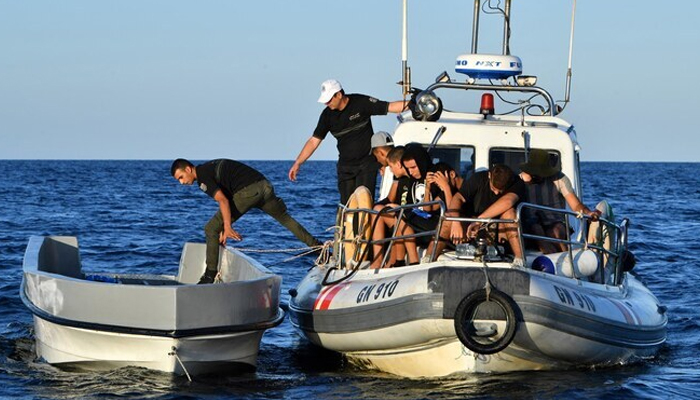Sports
NAP at 10: Assessing Pakistan’s response post-APS
字号+ Author:Smart News Source:Business 2025-01-13 07:29:54 I want to comment(0)
In big cities, small towns, and mountainous villages alike, TV channels flickered with breaking news alerts on . In the days that followed after the frantic scenes of parents waiting desperately outside Peshawar’s Army Public School, soldiers storming the building, and children and teachers fleeing in terror, Pakistan’s grief transformed into a strong resolve: never again. Across the country, as residents lit candles and organised protests, and families of the massacred turned to the courts for accountability, the collective heartbreak sent a strong message to those in power: this time, the outrage would not end with mere condolences. From newsrooms to political chambers and civil society huddles, in cities and villages alike, Pakistanis demanded real action and real change. Just eight days after the APS massacre, to answer this unified call. The parliament passed the “National Action Plan (NAP) for Countering Terrorism and Extremism”. Consisting of , the NAP presented a comprehensive strategy with a wide range of measures, including improving law enforcement capabilities and intelligence sharing, addressing challenging issues such as sectarian violence and extremism, and countering terrorist propaganda. A decade after the NAP’s launch, terrorism in Pakistan has not only increased, but its dynamics have evolved in complexity, particularly following the Taliban’s takeover of Afghanistan in August 2021. This piece will focus on the non-kinetic measures taken — or promised or hoped for — under the NAP’s framework in the aftermath of the APS tragedy. While Pakistan has long grappled with terrorism, particularly sectarian and ethnic violence during the 1980s and 1990s, the situation intensified in the 2000s following the US invasion of Afghanistan. The emergence of terrorist groups like the led to widespread violence, resulting in countless casualties. Initially, Pakistan’s response was reactive, involving small-scale military operations targeting terrorist strongholds. Syed Fakhar Kakakhel, a Peshawar-based journalist and author of , a definitive study on militancy, notes: “Post-9/11 until the APS tragedy, military commanders primarily led counterterrorism policies, which included banning terrorist groups, negotiation, and, when negotiations failed, small-scale operations, mostly in the former tribal areas.” In 2007, the Pervez Musharraf-led military regime that marked a turning point, prompting terrorists to target the state directly and leading to the TTP’s formation. During its government from 2008 to 2013, the Pakistan Peoples Party (PPP) introduced several new counterterrorism policies including what was called the — a three-pronged approach encompassing dialogue, deterrence, and development — and the , among other initiatives. However, these initiatives were hampered by the civilian government’s limited authority over security policy. Despite these constraints, the military launched and other parts of Khyber Pakhtunkhwa, including the former tribal regions. The October 2009 in Rawalpindi marked a shift in the military’s perspective on national security, recognising that the primary threats to national security were internal rather than external. After , the Nawaz Sharif-led government asked the military to — a full-scale offensive targeting the TTP and its allied groups, including al-Qaeda — just one week after the . The operation dealt heavy blows to terrorist groups but triggered intense retaliation, ultimately leading to the tragic attack on the APS in December 2014. Prior to the tragedy, in May 2014, the government had launched the , which was a precursor to the NAP. However, the NISP failed to gain momentum due to funding shortages, capacity constraints, and a lack of political consensus. The APS tragedy served as a shock to the system, galvanising Pakistani society and politics against terrorism. It marked a shift in the country’s counterterrorism approach, as a national consensus in the form of the NAP quickly emerged, committed to eradicating terrorism. However, the NAP has yet to achieve a measurable level of success, considering the resurgence of terrorist groups and activities in the country, which have 924 lives in the first 10 months of 2024 alone. The NAP’s limited success appears rooted in its implementation rather than its conception. Tariq Parvez, Nacta’s first national coordinator and a member of the committee that formulated the NAP, reveals that the policy was hastily crafted to meet a tight deadline set by then-prime minister Nawaz Sharif. Ideally, the NAP should have been implemented under the supervision of the Prime Minister’s Office, which has not been the case. While over a dozen ministerial monitoring committees were formed to track the NAP’s implementation, Parvez notes these proved ineffective, with apex committees at federal and provincial levels eventually becoming the primary bodies addressing terrorism issues. Security analysts point to broader structural issues. “Although all major political parties were consulted, it would have been beneficial to include provincial governments and Counter-Terrorism Departments (CTDs) in the formation of the NAP,” says Fakhar Kakakhel. “Each province faces unique security challenges, and their input could have ensured a more comprehensive and contextually relevant plan.” Despite these criticisms, Abdul Basit, Senior Associate Fellow at the S. Rajaratnam School of International Studies in Singapore, sees some value in the initiative: “Whether NAP was successful or failed is another debate. But in Pakistan, a counterterrorism policy was finally instituted and a framework and mechanism were enforced under the Nacta for the first time.” Ten years after the APS attack, the militant landscape within the country has grown increasingly complex, with terrorism evolving into new and varied forms. This shift raises pressing questions about the current status and effectiveness of the NAP: Has it achieved its objectives in reducing terrorism, or does it require reassessment to address today’s challenges? Both the public and policymakers are now critically examining its impact, questioning whether NAP has truly fulfilled its intended goals. This piece will briefly analyse to assess their relevance and effectiveness in the current context. The two action points swiftly implemented by the military after the NAP’s launch were: after a six-year moratorium and to expedite the prosecution of terrorism-related cases. Among the first individuals to be executed were those involved in high-profile attacks, including the 2003 and the 2009 attack on the GHQ. Initially, the lifting of the moratorium applied only to individuals convicted of terrorism-related offences. However, the scope was later broadened. By the end of 2015, , many convicted in non-terrorism cases, had been executed. This sparked a , as there was little concrete evidence linking executions to a reduction in terrorism or other serious crimes. To facilitate the formation of military courts, the government, with backing from various political parties, introduced . These amendments imposed severe penalties for unauthorised disclosures and expanded the jurisdiction of military courts, which ended up holding trials for those allegedly involved in the May 9 protests. In 2023, following the the section of the Pakistan Army Act, 1952, that allowed for the court martial of civilians, parliament introduced new amendments to the Act. These amendments imposed severe penalties for unauthorised disclosures and expanded the jurisdiction of military courts to include civilians allegedly involved in anti-government protests, which were primarily organised by Pakistan Tehreek-i-Insaf (PTI). In the early years following the NAP’s adoption, Pakistan intensified its crackdown on armed and banned groups, targeting their networks, supporters, and financing sources. However, this initial momentum slowed over time due to a combination of inconsistent implementation and shifting state priorities. The state’s response against these groups during this period included a range of actions: kinetic operations under (launched in 2017, following the success of Operation Zarb-i-Azb launched in June 2014), the banning of various groups, the arrest and conviction of their leaders and members, and the dismantling of their financial networks. But even before NAP was introduced, Pakistan had begun banning armed groups in August 2001. To date, it has , 22 of whom were added after the NAP’s launch. They included the Islamic State (Daesh), the TTP’s splinter groups, Jamaat-ud-Dawa, the Zainabyoon Brigade, Hafiz Gul Bahadur’s group, and ethnic separatist groups from Balochistan and Sindh. Experts argue that the list of banned outfits should be streamlined, as many groups rebrand or splinter only to reemerge under new names. “Due to mergers and reabsorptions, the actual number of distinct banned entities may be closer to 50,” says Kakakhel. For instance, the TTP has recently , complicating assessments of banned entities. The resurfacing of groups, such as Sipah-i-Sahaba Pakistan (SSP) further illustrates these challenges. Originally banned in 2002, SSP reappeared as Millat-i-Islamia Pakistan in 2003 and rebranded itself as the in 2012 (which was also banned). Despite repeated bans, the group remains active and even contests elections under the . In recent developments, the state’s decision to has stirred debate, with critics questioning whether . The government’s counterterrorism efforts have also weakened terrorist financing networks, largely driven by the . To combat money laundering and terror financing more effectively, a high-tech financial intelligence agency, the , was established in 2017. The FMU specialises in identifying patterns and geographical spread of terror financing, tracking its flow, and coordinating with relevant law enforcement agencies such as counterterrorism departments and the Federal Investigation Authority (FIA). “This effort has focused on tracking and dismantling funding channels that support terrorist groups, preventing banned groups from securing funds domestically, or internationally,” says a Karachi-based CTD official. “By disrupting these financial networks, Pakistan has targeted a critical support system for extremism.” However, experts emphasise that sustaining these gains will require ongoing vigilance and tighter financial oversight to prevent any resurgence. The NAP also aimed to curb sectarian violence and religious persecution and intolerance, but a decade later, its results have been mixed. Sectarianism continues to be a deeply entrenched issue within Pakistan’s religious and ideological landscape, shaped by both internal policies and external influences, especially the rivalries in the Middle East. Several key terrorists from the proscribed Lashkar-i-Jhangvi, such as and Ghulam Shabbir, were executed after the government lifted the death penalty moratorium. Leaders from both the ASWJ and Shia groups claim that over the years, law enforcement agencies have weakened militant elements within sectarian networks, . While this year remained largely linked to land disputes, the country witnessed a major sectarian flare-up . However, some experts believe that the decrease in sectarian violence is not solely attributable to the NAP. Parvez, the former Nacta coordinator, suggests that two primary factors contributed to this decline: the weakening of the Lashkar-i-Jhangvi and the TTP perceived shift away from sectarian violence, mirroring the Afghan Taliban. Despite facing temporary bans and restrictions, TLP has grown into a powerful force in both the political and religious spheres. The group taps into its broad support base and leverages public sentiment, especially surrounding blasphemy issues, to influence policy and social discourse. A decade into NAP, the struggle against sectarianism remains a formidable challenge, demanding consistent policy efforts and a strategic shift to address the ideological forces that sustain groups like TLP and foster religious persecution. Efforts to counter this violence, such as , often falter due to the intricate interplay of domestic and geopolitical dynamics. The influence of sectarian groups, particularly their links with actors in the Middle East, continues to exacerbate Pakistan’s internal crises. “While it’s true that sectarian violence has significantly reduced, it is crucial to remain vigilant against potential resurgence by groups like the Lashkar-i-Jhangvi and the Islamic State Khorasan Province,” Parvez says. The NAP set ambitious goals to limit extremist literature, strictly ban the glorification of terrorists in media, and curb the misuse of the internet and social media by militant groups. Over the past decade, significant progress has been made in shutting down extremist publications such as and . However, new challenges have arisen in the digital realm. Extremist content has increasingly migrated to less-regulated platforms such as Telegram, with groups like the Islamic State turning to and international channels to bypass restrictions and retain their influence. While social media monitoring has expanded and platforms have adopted stricter content moderation, bad actors continue to adapt, using secure messaging apps, VPNs, and coded language to evade detection. “As long as Telegram and other encrypted social platforms remain accessible, extremist groups, such as the TTP, will continue to utilise these channels to advance their agendas,” says Joshua Bowes, a researcher studying militant groups at the South Asia Foresight Network in Washington, DC. Pakistan has to curb extremist content, yet the rapidly evolving digital landscape calls for continuous innovation in counterterrorism strategies to stay ahead of these adaptive threats. However, after the February 2024 general election, the government has increasingly employed these strategies as part of a broader crackdown on political dissent, focusing particularly on PTI supporters. In February, authorities , a social media platform heavily utilised by PTI’s support base, citing “national security” concerns. This move further marginalised the party’s online presence and restricted avenues for political expression. Since May, military discussions have adopted the term , widely seen as a veiled reference to PTI’s supporters, escalating the crackdown on digital activists linked to the party. Digital freedom in Pakistan has long been constrained. Internet shutdowns are common during religious festivals to curb dissent and prevent unrest. scoring it 26/100 on internet freedom. The , long accused of fostering radicalisation, have been among the most contentious aspects of the NAP. Abdur Rehman Shah, a research scholar who has , says these institutions had faced mounting scrutiny since the post-9/11 period, but with the launch of the NAP in 2014, state intervention reached unprecedented levels. “The state — mostly led by security and military institutions in this case — kick-started the process of geo-tagging madressahs, conducting raids, and carrying out interrogations and arrests at seminaries suspected of ties to banned terrorist groups,” Shah says. A major milestone in the madressah reform effort came in 2019 when the Ittehad Tanzeemat-i-Madaris Pakistan (ITMP) — a coalition representing all five madressah boards — with the Directorate General of Religious Education under the Ministry of Education. In return, the state and , addressing longstanding administrative obstacles these institutions face. However, experts pointed to major challenges in securing widespread cooperation. Some religious leaders, particularly , opposed greater alignment between madressahs and state regulations. When in 2021 to reduce the influence of the established boards, Wifaq-ul-Madaris Al-Arabia Pakistan, the Deobandi madressah board, expelled seminaries associated with these new entities. Recent legislative developments have once again shifted madrassah oversight. “To gain the JUI-F’s support for passing the 26th Constitutional Amendment, the government conceded its hard-won — albeit formal — victory from the 2019 agreement, of registering madressahs under the Societies Registration Act (1860),” Shah notes. Last week, however, President Asif Ali Zardari to Parliament due to “several technical flaws”. When the Maulana learnt of this development, he threatened to launch protests against the government to force it to accept the bill. Even as the fate of the bill remains to be seen, despite a decade of effort under the NAP, madressah reforms continue to face significant resistance and setbacks. The National Counter-Terrorism Authority (Nacta), founded by ordinance in 2009 and ratified by parliament in 2013, was envisioned as the lead agency for coordinating Pakistan’s counterterrorism efforts. Despite this mandate, Nacta has faced persistent challenges in realising its potential, primarily due to institutional hurdles, budget constraints, and bureaucratic obstacles. “Nacta’s potential remains largely untapped as it continues to operate in an environment of fragmented inter-agency coordination,” says Tariq Parvez, Nacta’s first national coordinator. A Nacta official, who spoke on condition of anonymity, revealed that the organisation still lacks provincial offices, sufficient staff, and adequate funding. Powerful stakeholders, including federal intelligence agencies and provincial governments, have yet to fully support Nacta’s mission, and many experts argue that without comprehensive support, Nacta cannot effectively consolidate and lead counterterrorism initiatives. “Nacta’s empowerment means it should be made directly responsible to the prime minister as laid down in the original Act,” Parvez emphasises, suggesting that a direct line to the highest levels of government would help Nacta function as intended. In an apex committee meeting in late November, chaired by Prime Minister Shehbaz Sharif in Islamabad, the government once again along with the establishment of a “National and Provincial Intelligence Fusion and Threat Assessment Centre”. However, the apex committee offered little clarity on the specific measures or strategies to implement these initiatives. The National Action Plan also called for a specialised counterterrorism force to address the gaps left by conventional law enforcement in dealing with terrorism’s unique challenges. Reports have indicated that the government proposed establishing a . This department would be empowered to conduct counterterrorism operations nationwide, pending approval from the prime minister. Zoha Waseem, a policing expert at the University of Warwick in UK, says that establishing such force allows for policing tasks, including intelligence collection and investigation, to be more focused. “Routine policing should be separate from counterterrorism policing as routine police work should be community-oriented and in service of the public, while counterterrorism policing has a very different function,” she says. A centralised counterterrorism force would enhance the capacity to target, prevent, and dismantle terrorist networks, especially as terrorists employ increasingly sophisticated methods. “Counterterrorism policing should not be equated with regular police work as it corrupts the culture of the police and creates the possibility that every public order issue will be treated as a national security issue,” cautions Waseem. . By fostering a unified strategy, a centralised force could offer specialised skills and resources, reinforcing the work of provincial CTDs and ensuring a coordinated approach to counterterrorism across Pakistan. The for the past four decades has remained a multifaceted issue, often intertwined with concerns over national security and terrorism. Although Pakistan’s approach toward Afghan nationals began to shift in 2005, the NAP explicitly identified the repatriation of Afghan refugees as a key objective, aiming to mitigate potential security risks associated with unregulated migration. Following the launch of the NAP, Pakistan initiated a crackdown in late 2016, which was characterised by Human Rights Watch as the world’s in recent times. Despite this, many Afghans remained in the country, highlighting the limitations of the state’s ability to repatriate them fully. However, after the Taliban’s takeover of Afghanistan in August 2021, the Pakistani government’s stance toward Afghan refugees in the country hardened. This shift was largely driven by heightened security concerns stemming from a resurgence of TTP’s deadly attacks and deteriorating political relations between Islamabad and the Taliban-led administration in Kabul. It led to on Afghan refugees in late 2023, resulting in the forced or voluntary repatriation of nearly half a million Afghan nationals. The recent wave of expulsions underscores the complexities involved in managing such a significant refugee population, which according to the UNHCR. Pakistan lacks a aligned with international standards, which poses challenges to the fair treatment of those deemed ‘undocumented’. This legal gap not only complicates Pakistan’s efforts to address security concerns but also raises humanitarian issues, particularly for Afghan families who have lived in Pakistan for generations and integrated into local communities. The NAP included a mandate to expedite administrative and developmental reforms in the former . The goal was to counter militancy by addressing the root issues of political exclusion, lack of governance, and poverty that made the region vulnerable to extremist influence. Historically, Fata’s remote location and limited government control allowed it to become a , including the TTP, who used the area as a base for attacks across the country. Security observers and regional analysts had long pointed to the region’s outdated administrative structure under the , which denied residents basic rights and undermined local governance, as a significant factor enabling militancy. In 2018, a historic step was taken with the , replacing the colonial-era FCR with Pakistan’s constitutional framework. This merger aimed to provide Fata’s people with access to rights, representation, and services on par with citizens nationwide, envisioning a future of stability, security, and development in a region that had been underdeveloped and marginalised for decades. However, the challenges of integration have proven more complex than anticipated. Despite the merger, the promised benefits for residents have been slow to materialise, with significant delays in implementing development projects and infrastructure improvements. The KP government has pointed out that while the province’s population has increased significantly with the merger, its share in the , creating financial constraints that hinder progress. Bureaucratic hurdles, insufficient funding, and persistent security threats have hampered progress, leaving many locals disillusioned by the lack of visible change. Health, education, and employment opportunities remain limited, contributing to frustration and, according to some analysts, leaving the region vulnerable to exploitation by militants. In recent negotiations with the government, the TTP has even . Without a significant investment in infrastructure, social services, and economic development, the goals of NAP to prevent militancy through local empowerment in former tribal areas will remain challenging. The NAP identified the and emphasised empowering the provincial government to initiate a ‘reconciliation’ process with disgruntled Baloch leaders. This approach aimed to address the underlying causes of discontent in the region, primarily political marginalisation, economic exclusion, and historical grievances. After the launch of the NAP, then-chief minister of Balochistan, Abdul Malik Baloch, acting , initiated discreet negotiations with , in Europe. However, these efforts saw limited success, primarily due to insufficient support from the military and the eventual replacement of Baloch with Sanaullah Zehri as chief minister after two-and-a-half years, as per a political agreement. Zehri with exiled leaders, effectively ending the initiative. Meanwhile, other efforts particularly promoting economic development, and implementing reintegration initiatives for militants willing to lay down arms, saw a measure of success in the initial years. Between 2015 and 2020, Balochistan’s insurgency was due to sustained counterinsurgency operations, internal rifts among separatist groups, and . While some Baloch political parties advocate for provincial rights through elections and other political avenues, other groups have returned to armed resistance, claiming that peaceful efforts have failed. In recent years, separatist groups have shown growing sophistication in their tactics and operational capabilities. The banned and other factions have not only targeted infrastructure projects and security posts within Balochistan but have also expanded their attacks to other regions, including the port city of Karachi, and begun targeting , who are working under the China-Pakistan Economic Corridor (CPEC). The rise in terror attacks has forced the Pakistani government in mid-November to approve a new, aimed at dismantling separatist groups. However, specifics about the operation, including its scope and timeline, remain unclear, raising questions about its strategy and potential effectiveness. When the NAP was launched, two of its central objectives were: stabilising Karachi’s worsening law and order situation and curbing the influence of militant groups in Punjab, where government statistics indicated that . Over the past decade, efforts to address these twin challenges have yielded variable outcomes, reflecting the complexity of both regions’ unique security landscapes. In Karachi, a had already begun in September 2013 to curb violence and criminal activity in the country’s largest city. The operation targeted the armed wings of political parties, , criminal syndicates and sectarian groups, and succeeded in lowering the homicide rate in the city. However, the operation has faced criticism for its lack of long-term institutional reforms and perceived political motivations, particularly in the dismantling of the Muttahida Qaumi Movement (MQM). Experts argue that this has created a in a city characterised by its , with urban-rural and ethnic tensions re-emerging in . They warn that if these underlying governance issues and ethnic disparities remain unaddressed, Karachi risks sliding back into ethnic violence, potentially undoing the gains of the operation. In Punjab, NAP’s implementation focused on that were fostering extremism in the region. Initiatives included enhanced intelligence-sharing, increased police-led counterterrorism operations targeting such as Lashkar-i-Jhangvi, TTP, the Islamic State, and restrictions on hate speech and extremist literature. These measures contributed to a noticeable decline in sectarian and terrorist attacks, enhancing safety across the province. Despite these successes, militancy in Punjab presented unique challenges due to the high population density and deep-rooted influence of certain extremist groups, which complicated surveillance and containment efforts. In connection with NAP’s 10-year review, the state’s efforts in Karachi and Punjab have brought relative stability but highlight the need for comprehensive approaches that tackle both immediate security threats and the underlying social and political issues that fuel militancy and crime. A decade after the APS tragedy, Pakistan finds itself grappling with both old and emerging threats. The NAP, born out of national unity in the wake of the horrific APS attack, achieved significant progress in its early years by dismantling major militant networks and curbing large-scale terror attacks. However, as attacks plateaued, so did vigilance, allowing radicalisation to take root and threats to evolve. This complacency was perhaps best captured by then-federal minister : “We have prevailed from victims to victors” — a sentiment that now seems premature. Alongside severe economic challenges and deep political divides, the country faces renewed threats from a range of terrorist groups, including the TTP and ethno-separatist terrorist groups like the BLA. These issues underscore the fragmented implementation of the plan and the enduring need for a more comprehensive strategy. These security threats are further complicated by a Taliban-led Afghanistan, which provides sanctuary to many of these groups and exacerbates border challenges. The current situation also demands a decisive shift to address the ideological forces sustaining groups like the TLP. This involves investing in counter-narratives to extremist ideologies, integrating these narratives into educational and religious institutions, and leveraging platforms like to foster interfaith harmony and tolerance. Addressing the ideological underpinnings of extremism through educational and religious counter-narratives, empowering agencies like Nacta, and building capacity within provincial CTDs are essential for sustained success. Equally crucial is tackling sociopolitical grievances in vulnerable regions through genuine political engagement and targeted economic investments. The lessons of the past ten years underscore that fragmented efforts will no longer suffice. Parvez, Nacta’s former coordinator, says that the experiences of the past ten years underscore the inadequacy of fragmented counterterrorism approaches. “To secure lasting peace and stability in the complex contemporary militant landscape, amidst significant geopolitical challenges, Pakistan must cultivate a unified, research-driven vision that seamlessly integrates security measures with the aspirations of its people,” says Parvez. “This will ensure that the sacrifices made following the APS tragedy are not in vain.”
1.This site adheres to industry standards, and any reposted articles will clearly indicate the author and source;
 Related Articles
Related Articles-
Sindh to seek return of transport dept land from govt bodies
2025-01-13 06:34
-
POL opposes gas sale deal from govt-partnered Razgir field without bidding
2025-01-13 06:21
-
POL opposes gas sale deal from govt-partnered Razgir field without bidding
2025-01-13 06:06
-
POL opposes gas sale deal from govt-partnered Razgir field without bidding
2025-01-13 06:03
 User Reviews
User Reviews Recommended Reads
Recommended Reads Hot Information
Hot Information- May 9 masterminds behind killing of Rangers men: governor
- POL opposes gas sale deal from govt-partnered Razgir field without bidding
- POL opposes gas sale deal from govt-partnered Razgir field without bidding
- POL opposes gas sale deal from govt-partnered Razgir field without bidding
- Rawalpindi court issues non-bailable arrest warrant for Bushra Bibi in £190m case
- POL opposes gas sale deal from govt-partnered Razgir field without bidding
- POL opposes gas sale deal from govt-partnered Razgir field without bidding
- POL opposes gas sale deal from govt-partnered Razgir field without bidding
- Gaza’s 130,000 children deprived of food, medicine: Save the Children
 Abont US
Abont US
Follow our WhatasApp account to stay updated with the latest exciting content













